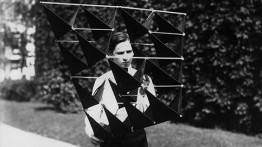The Tetrahedral Kites of Alexander Graham Bell
Tue, Nov 13, 2018 12am - Tue, Dec 11, 2018 11:59am

Bell, Alexander Graham. Journal by Alexander Graham Bell, from January 2, 1903 to August 26, 1904. June 18, 1903. Manuscript/Mixed Material. Library of Congress, Washington, D.C.
Third Floor Hallway Gallery – Foundation Building
Open to Students, Faculty, and Staff
This exhibition provides a brief visual survey of the tetrahedral kites developed by Alexander Graham Bell at the turn of the 20th century. At Beinn Bhreagh, his estate in Baddeck, Nova Scotia, Bell guided a team of skilled engineers and fabricators as they systematically probed and documented the performance of a diverse, imaginative array of kite designs. While Bell’s work resulted in technical innovations that advanced early aviation, his massive kites and aerodromes were unsuccessful in powered flight. Their development, however, led to Bell’s discovery of tetrahedral trusses and space frames decades before their widespread adoption by architects and engineers.
Curated by Chris Dierks
The Irwin S. Chanin School of Architecture
The Cooper Union
Located at 7 East 7th Street, between Third and Fourth Avenues




